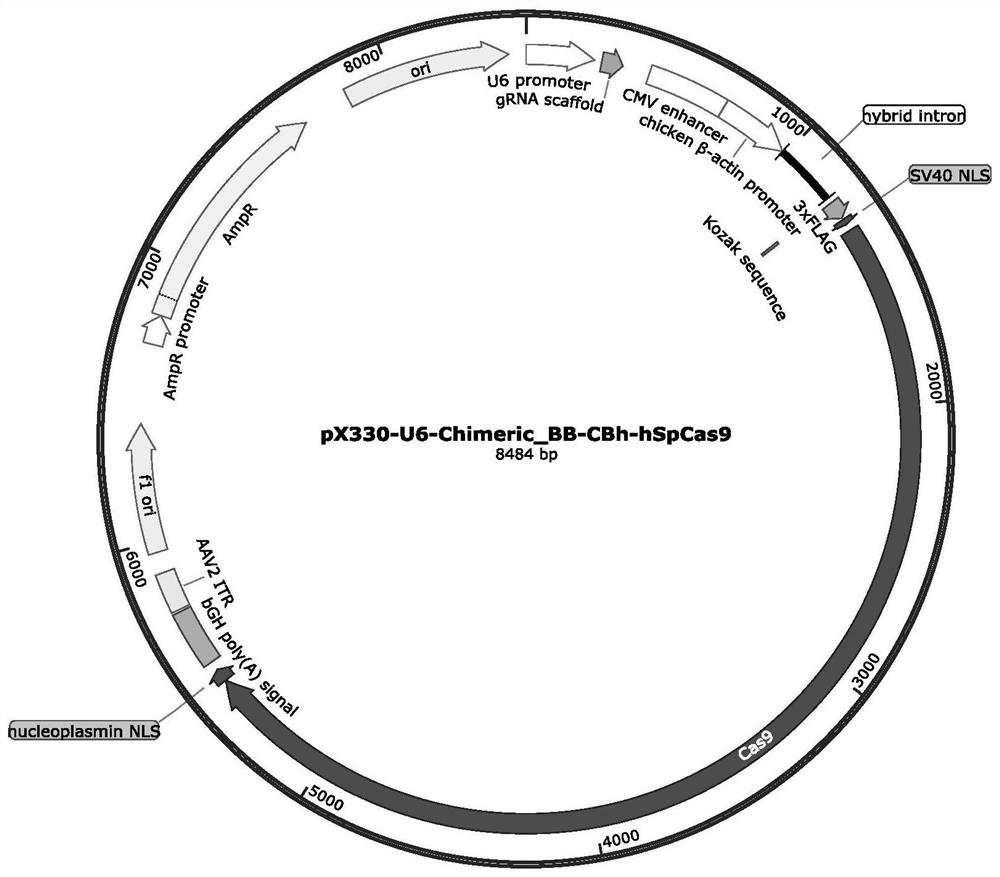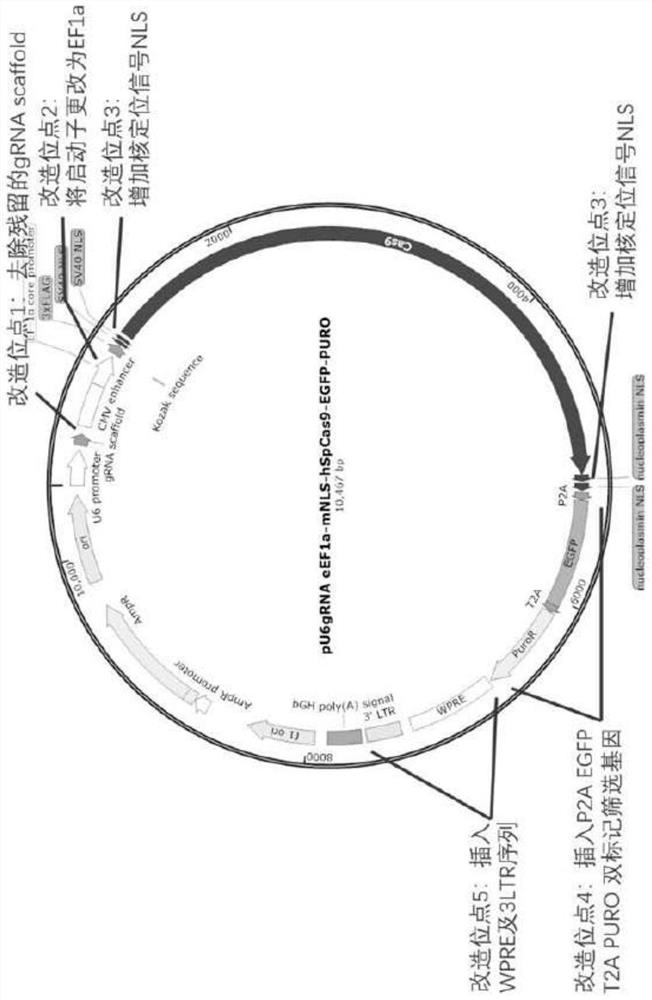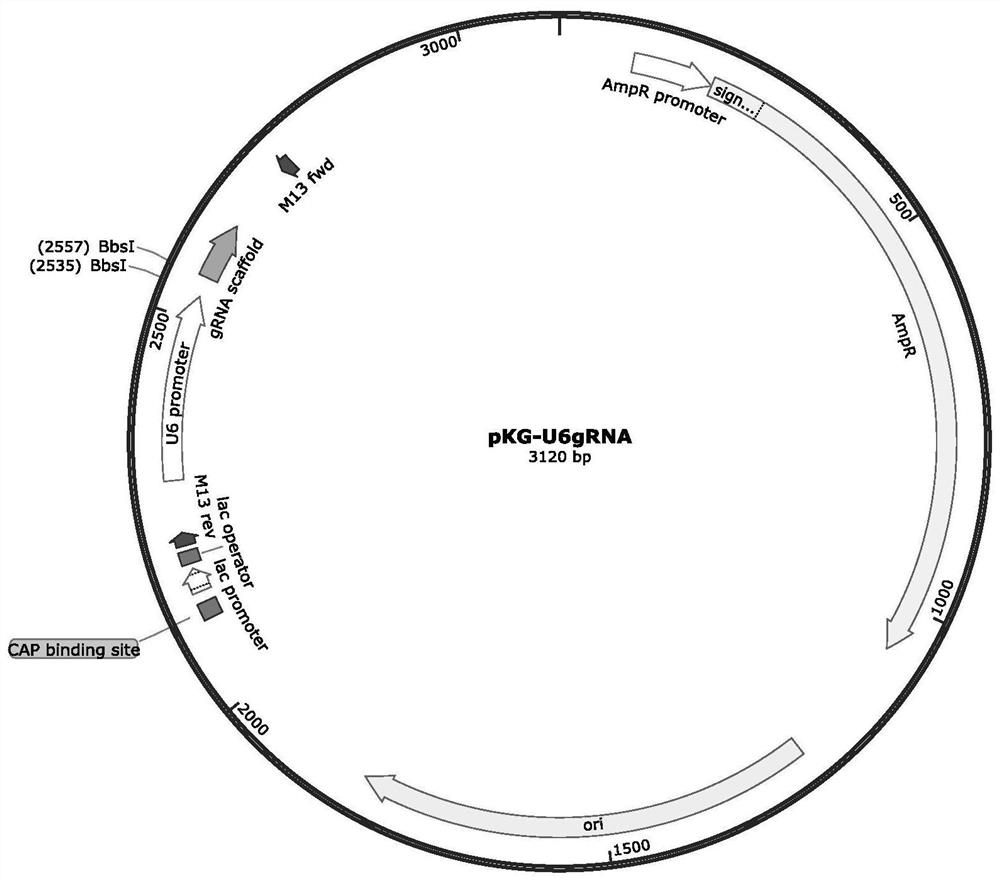CRISPR system and application thereof in constructing LRP5 gene mutation osteoporosis cloned pig nuclear donor cell
A gene and gene editing technology, applied in the field of gene editing, can solve the problems of low probability of homozygous mutant offspring and inapplicability, and achieve the effect of improving nuclear localization ability, good applicability, and increasing the number of nuclear localization signals
- Summary
- Abstract
- Description
- Claims
- Application Information
AI Technical Summary
Problems solved by technology
Method used
Image
Examples
Embodiment 1Ca
[0074] The construction of embodiment 1 Cas9 high-efficiency expression vector and the construction of pKG-U6gRNA vector
[0075] 1.1 Construction of pU6gRNA-eEF1a-mNLS-hSpCas9-EGFP-PURO (Cas9 high-efficiency expression vector)
[0076] (1) Remove redundant and invalid sequences in the gRNA backbone
[0077] pX330-U6-Chimeric_BB-CBh-hSpCas9 (referred to as pX330, figure 1 ) was digested with BbsI and XbaI, and the vector fragment (about 8313bp) was recovered, and the insert fragment 175bp (SEQ ID NO: 31) was synthesized by the multi-fragment recombination method, and recombined with the recovered vector fragment to obtain the pU6gRNACas9 vector ( figure 2 ).
[0078] (2) Transformation of promoters and enhancers
[0079] For the constructed pU6gRNACas9 vector, use XbaI and AgeI endonucleases to remove the promoter (chickenβ-actin promoter) and enhancer sequence (CMV enhancer), recover the linear vector sequence of about 7650bp, and use the multi-fragment recombination meth...
Embodiment 2
[0094] Example 2 Plasmid Proportion Optimization and Effect Comparison of Plasmid pX330 and Plasmid pKG-GE3
[0095] 2.1 gRNA target design and construction
[0096] 2.1.1 Using Benchling to design gRNA targets for the RAG1 gene
[0097] RAG1-gRNA4: AGTTATGGCAGAACTCAGTG (SEQ ID NO: 4)
[0098] The insert sequence complementary DNA oligo of the synthetic RAG1 gene is as follows:
[0099] RAG1-gRNA4S: caccgAGTTATGGCAGAACTCAGTG (SEQ ID NO: 5)
[0100] RAG1-gRNA4A: aaacCACTGAGTTCTGCCATAACTc (SEQ ID NO: 6)
[0101] Both RAG1-gRNA4S and RAG1-gRNA4A are single-stranded DNA molecules.
[0102] 2.1.2 Primers designed to amplify the fragment containing the RAG1 gRNA target
[0103] RAG1-nF126: CCCCATCCAAAGTTTTTAAAGGA (SEQ ID NO: 7)
[0104] RAG1-nR525: TGTGGCAGATGTCACAGTTTAGG (SEQ ID NO: 8)
[0105] 2.1.3 The method of cloning the gRNA sequence into the pKG-U6gRNA backbone vector
[0106] 1) Digest 1ug pKG-U6gRNA plasmid with restriction endonuclease BbsI;
[0107] 2) run the d...
Embodiment 3
[0155] Example 3 Design and construction of LRP5 gene target
[0156] 3.1 Genomic DNA extraction
[0157] 18 pigs (male A, B, C, D, E, F, G, H female 1, 2, 3, 4, 5) were respectively performed using Vazyme's FastPure Cell / Tissue DNA Isolation Mini Kit (VazymeCat.DC102-01). , 6, 7, 8, 9, 10) Genomic DNA from ear tissue was extracted by column, quantified using NanoDrop, and stored at -20°C for future use.
[0158] 3.2 Conservation analysis of predetermined targets of LRP5 gene knockout and adjacent genome sequences
[0159] 3.2.1 Gene information of pig LRP5
[0160] Encodes LDL receptor-associated protein 5; located on chromosome 2; GeneID is 100524299, Sus scrofa. The amino acid sequence encoded by the pig LRP5 gene is shown in SEQ ID NO:10. Existing research results have shown that LRP5 plays a central role in bone mass regulation. In pig genomic DNA, the LRP5 gene has 25 exons, of which the sixth exon occupies an important position in all transcripts (porcine LRP5 gene ...
PUM
 Login to View More
Login to View More Abstract
Description
Claims
Application Information
 Login to View More
Login to View More - R&D
- Intellectual Property
- Life Sciences
- Materials
- Tech Scout
- Unparalleled Data Quality
- Higher Quality Content
- 60% Fewer Hallucinations
Browse by: Latest US Patents, China's latest patents, Technical Efficacy Thesaurus, Application Domain, Technology Topic, Popular Technical Reports.
© 2025 PatSnap. All rights reserved.Legal|Privacy policy|Modern Slavery Act Transparency Statement|Sitemap|About US| Contact US: help@patsnap.com



